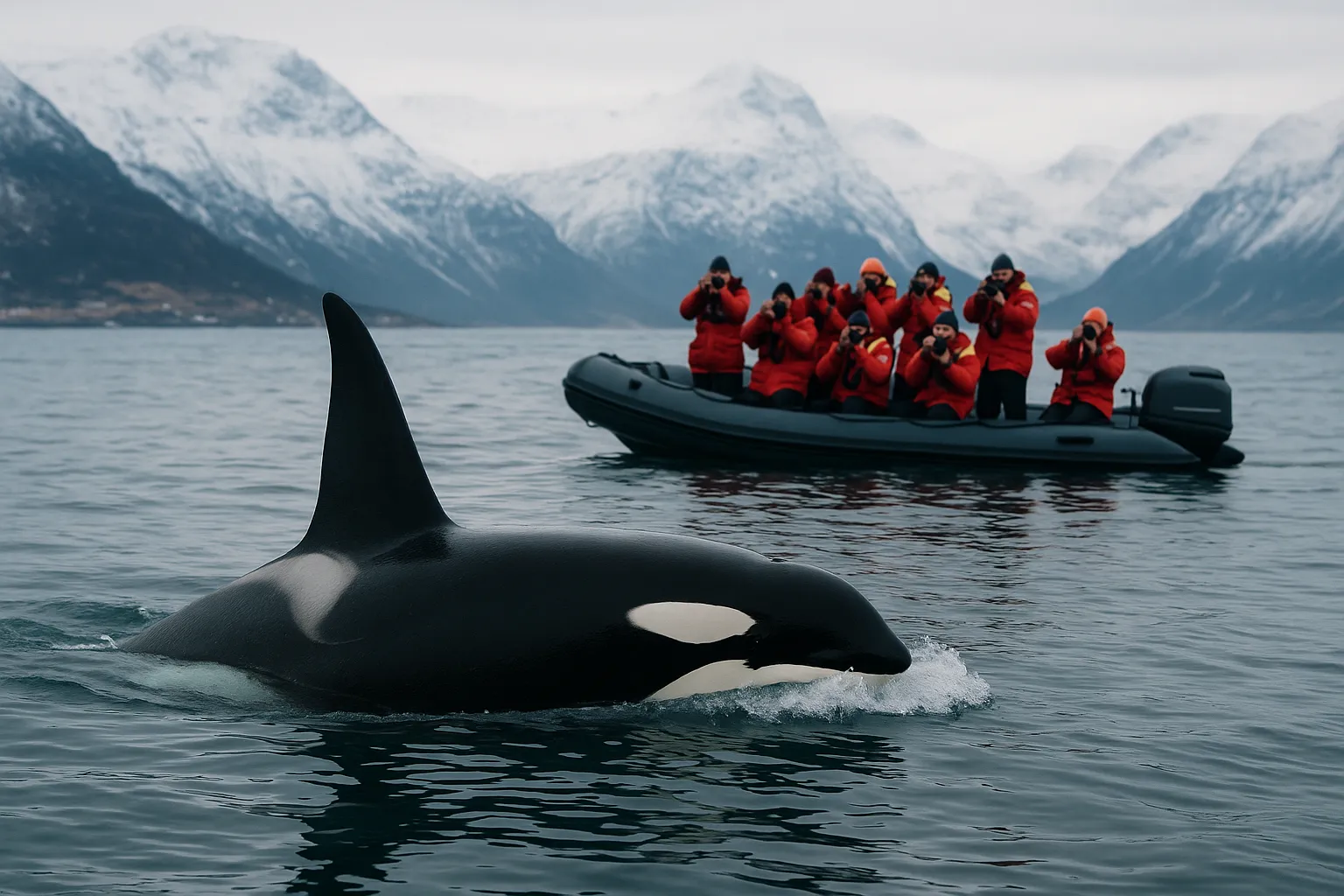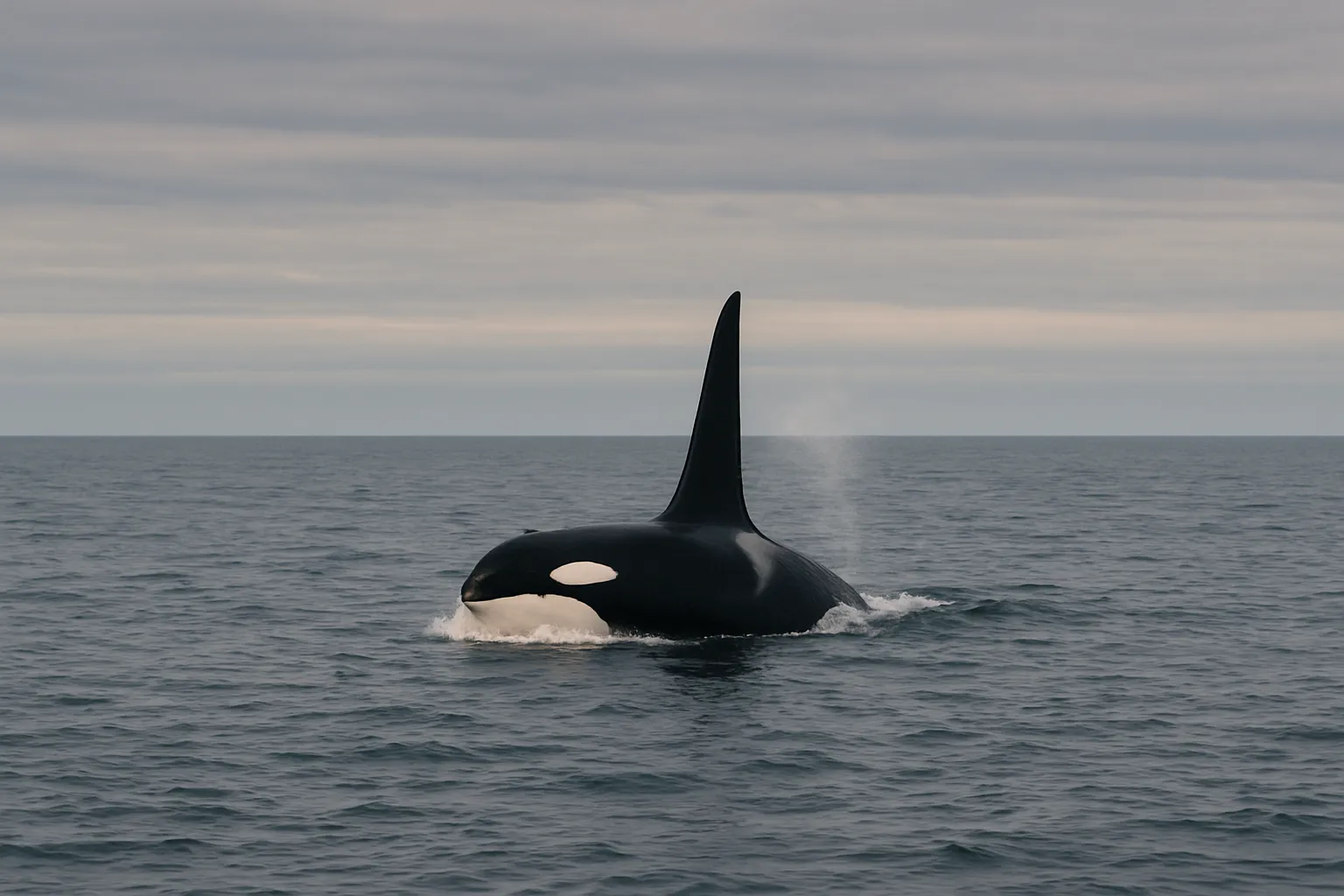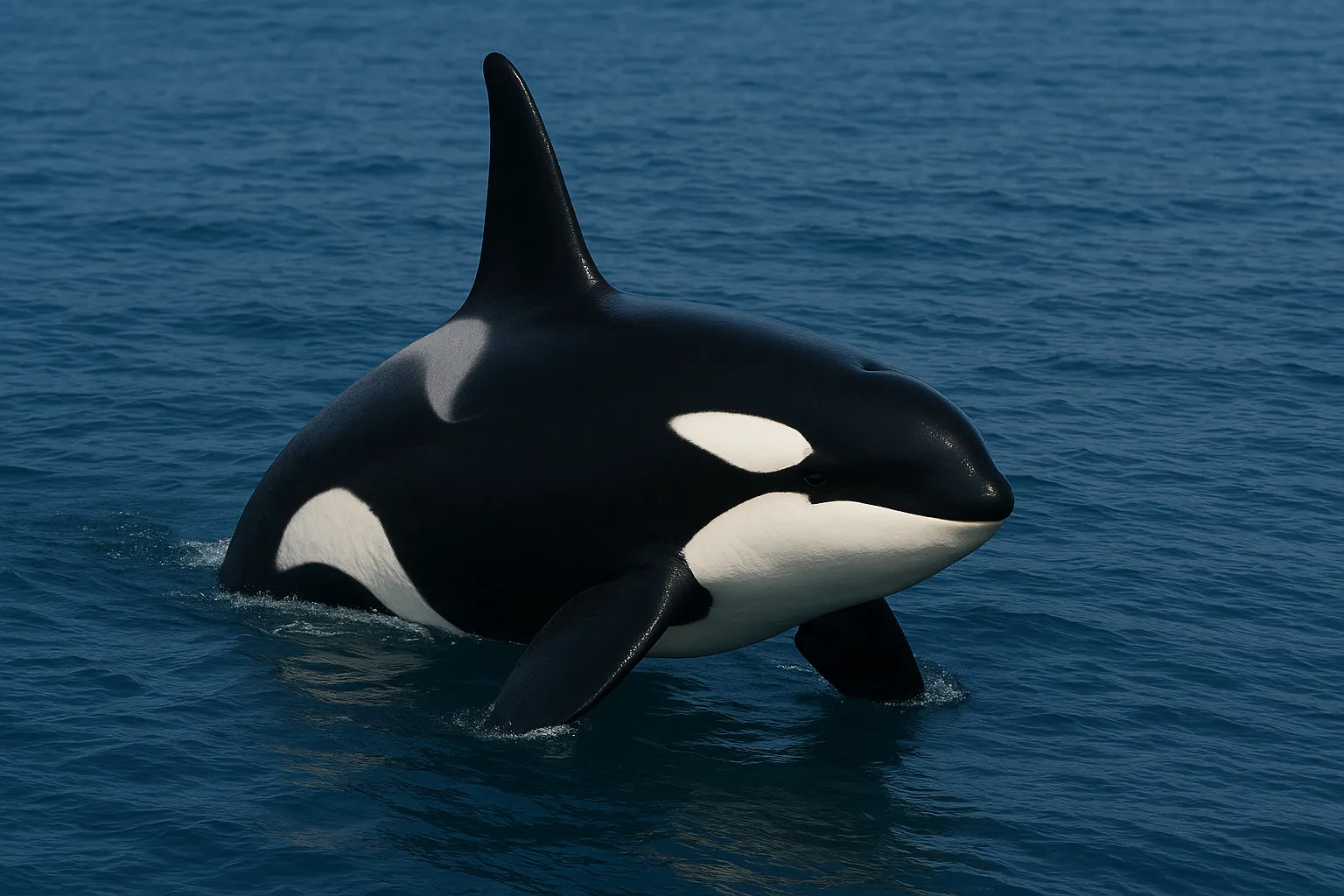
TL;DR
For a boat-based orca safari near Tromsø, late November through December is the optimal time, with Skjervøy and its fjords being the go-to location for reliable sightings. Both November and December offer strong chances of seeing orcas (and humpbacks), though late Nov/early Dec may give a tad more daylight while mid/late Dec offers the full polar-night ambience. Avoid going too late in January/February.
Peak Orca Season in Tromsø Region
Tromsø’s prime whale-watching season is the winter months. Each year, from early November through January, large numbers of orcas (killer whales) and humpback whales arrive in the fjords of northern Norway to feed on massive schools of herring[1][2]. This annual migration creates a spectacular safari opportunity – it’s common to witness dozens or even hundreds of whales in the area during peak season. In fact, some expeditions have reported seeing hundreds of orcas alongside dozens of humpbacks on peak-season days[3]. Outside of this winter window, sightings drop off sharply (by February the whales have typically moved on)[4], so planning your trip between November and January will maximize your chances of encounters[5].
Orca behavior: The winter orca gatherings are driven by food. Each winter, huge shoals of Atlantic herring congregate in the fjords to overwinter and spawn, and the orcas (along with humpbacks) follow this food source. The orcas often hunt cooperatively, herding the herring into tight balls before feeding. This means the whales tend to concentrate in specific fjords where herring are abundant. It’s a dynamic, seasonal phenomenon – the orcas migrate to these coastal fjords in search of herring from November to January[1], then depart once the herring disperse. This winter herring feast is what makes the Tromsø region one of the best places in the world to see orcas in the wild[6].
November vs. December – Which Is Better?
Both November and December fall squarely within Tromsø’s orca peak season, and both months generally offer excellent whale sighting odds. Orcas typically begin appearing by late October or early November, with significant numbers present by mid-November as the herring schools arrive[7]. Sightings are highly reliable through late November and all of December – local experts note that from mid-November until mid-January your chances of encountering whales are “as good as they get”[8]. In practice, a trip in late November or any time in December should provide very high likelihood of orca sightings[9]. There isn’t a strict “better” choice between these two months; both are prime time for orca safaris.
That said, here are a few nuances to consider:
- Early November vs. Late November: Early November is the start of the season, so if the herring arrive a bit late in a given year, whale numbers in the first week or two of November might be lower. By mid/late November, however, the orcas and humpbacks are usually in full force[9]. Planning for the second half of November can be a safe bet to ensure the whales have arrived in large numbers.
- December conditions: December is firmly within the peak feeding period, so whale activity is typically just as high as (or even higher than) late November. Many tour operators consider December a peak month for orcas and humpbacks in northern Norway[10]. Do note that December in Tromsø coincides with the polar night (no direct sunlight – see Daylight section below), but tours still operate daily and whales are visible during the limited daylight/twilight hours[11]. Also, December sees more tourist demand – it’s holiday season and a popular time to visit Tromsø. Tours and hotels can book up quickly in December’s peak period[12], so if you choose December, reserve your whale safari and accommodation well in advance.
- January (for context): Early January can also be very good for orcas, but by mid-to-late January the herring may begin to leave, and accordingly whale sightings taper off[9]. Since you’re looking at Nov/Dec, this mainly means you’re targeting the heart of the season.
Bottom line: Both November and December are excellent for orca safaris in the Tromsø area. If anything, late November through December is the most consistently reliable period for orca encounters[9]. Go with what fits your schedule, and consider the trade-off between late November’s slightly longer daylight versus December’s festive atmosphere (but 24-hour darkness). With proper planning (and warm clothing!), you can expect a memorable orca experience in either month.
Where to See Orcas: Key Areas and Fjords Near Tromsø
An orca surfaces in the Arctic fjords near Skjervøy (north of Tromsø) during winter. Location is key for a successful orca safari. In recent years, virtually all the whale action has centered north of Tromsø, around the island of Skjervøy and its surrounding fjords (such as the Kvænangen fjord)[13]. Skjervøy is about 200–250 km north of Tromsø (approximately a 3-4 hour journey by road or a couple of hours by boat)[14]. This area has become the hotspot for winter orcas and humpbacks, because that’s where the herring have been gathering in winter. Each day, safari boats head to the cold fjords near Skjervøy to find whales actively feeding in the herring-rich waters[14]. Orcas and humpbacks often patrol these fjords side by side, surfacing and diving as they feast – an awe-inspiring sight against the backdrop of snowy peaks and midwinter light.
It’s worth noting that a decade ago, whales could be seen much closer to Tromsø – for example, around the fjords of Kvaløya (an island just outside the city). However, the herring “pantry” shifted north a few years back, and the orcas followed. Since about 2017, the orca and humpback winter congregation has stayed in the Skjervøy area rather than near Tromsø’s immediate coast[15]. No one knows if this pattern will change again, but for now Tromsø-based tours all go north to where the whales are. In practical terms, this means many tours include either a long boat transfer or a bus+boat combo to reach the Skjervøy waters[16][17]. The journey is absolutely worth it – these northern fjords are where you’ll have the highest chance of orca sightings, as they’ve been the whales’ preferred feeding grounds in recent winters[13]. (Some lucky locals do glimpse whales from shore in that region on occasion, but a boat trip offers the best encounters, often with curious orcas coming right up near the vessel[18].)
Tip: If you’re staying in Tromsø city, you can either join a tour that departs Tromsø by boat (usually larger boats/catamarans that travel to Skjervøy) or take a tour that uses a bus to Skjervøy then a smaller boat from there. Travel time will be several hours each way either method. Many operators offer a seamless package – for example, a coach transfer to Skjervøy in the early morning, then a whale safari by RIB or small boat, returning to Tromsø by evening[19]. This gets you right into the heart of orca territory without having to worry about logistics. If you’re an independent traveler, it’s also possible to drive or take public transit to Skjervøy on your own and join a local boat tour from there[20], but most visitors find it easiest to go with an organized tour from Tromsø.
Reputable Orca Safari Tour Operators (By Boat)

Tromsø has several well-regarded tour operators that run orca (whale) safaris in November–January. All tours are boat-based (there are no orca-watching flights or the like – you’ll be on a vessel). Below are a few examples of reputable operators known for quality experiences in this season:
- Brim Explorer – Offers a “silent” whale watching cruise on a large hybrid-electric catamaran[21]. This full-day tour leaves Tromsø by boat and heads to the whale grounds. The boat has warm indoor lounges, a café, restrooms, and spacious decks. Brim’s hybrid engine allows the captain to switch to near-silent electric propulsion in the whale areas, minimizing disturbance to the orcas and providing a more eco-friendly experience[21]. This is a great option if you prefer comfort and stability (and a bit of luxury) while still getting excellent viewing opportunities. (Note: Brim Explorer’s tours are very popular; in peak season, they often sell out in advance.)
- Dervola Adventure – A small-group local operator based out of Skjervøy, highly praised for intimate and ethical whale safaris[22]. They use smaller boats (RIBs or a modest-sized vessel carrying around 10–12 passengers) which allows for an up-close experience and the flexibility to move where the whales are. Dervola’s guides are knowledgeable locals who genuinely care about the whales’ welfare and follow respectful approach guidelines[22]. If you’re interested in a more personal, adventurous tour (and don’t mind a bit of Arctic wind in your face!), this kind of small-boat trip is ideal. You’d typically meet in Skjervøy for these tours – some packages can include a Tromsø–Skjervøy transfer, or you can travel to Skjervøy independently.
- Arctic Whale Tours – A larger tour company offering winter whale safaris from both Tromsø and Skjervøy. They operate a comfortable, heated classic boat (“historic Hagbart Waage”) for the Skjervøy trips[23], as well as full-day safaris departing Tromsø harbor. Arctic Whale Tours emphasizes sustainability and even provides a “whale sighting guarantee” – if no whales are seen, you can join another trip for free[24][25]. This operator is a good choice if you value amenities like indoor seating and onboard meals, and the peace of mind of a sighting guarantee. (They are known for knowledgeable guides and even offer photography advice during the tour.)
These are just a few examples – there are other operators as well, including those running RIB (rigid inflatable boat) safaris and additional local outfits in Skjervøy. When choosing, consider your comfort level with boats: RIB tours can be thrilling and get you very close to whales, but they are open-air and fast (expect an extremely cold ride and a bumpy sea on rough days). Larger vessels or catamarans offer warmth and shelter, though with more fellow passengers. Many Tromsø visitors opt for the bigger boat from Tromsø for comfort, while hardcore wildlife enthusiasts sometimes prefer heading to Skjervøy for a small-boat or RIB excursion to maximize time among the whales[17][26]. Regardless of the platform, ensure the operator follows responsible whale-watching guidelines (most in Tromsø do). Booking through Visit Tromsø’s official list or reading up-to-date reviews can help confirm an operator’s reputation.

Weather and Daylight Considerations
Daylight (or lack thereof): Tromsø lies far above the Arctic Circle, which means polar night in winter. From about late November to mid-January, the sun does not rise above the horizon at all[11]. If you’re visiting in November or December, be prepared for very short days. In mid-November you’ll get a few hours of daylight (the sun is low on the horizon for a brief time), but by December, the sun is gone – instead, you’ll have a period of blue-grey twilight for a few hours around midday. Don’t worry, it’s not pitch black the whole time; even at the height of polar night there is enough ambient light around midday to spot whales and enjoy the scenery[11]. The sky often glows with deep blue, purple, or pink hues during these twilight hours, creating a gorgeous backdrop for whale watching[27]. (Many travelers find the polar night lighting very atmospheric – imagine orcas surfacing against a pink-orange twilight sky and snow-covered mountains[28].) Tours are timed to take advantage of this light: typically departing in early morning darkness and reaching the whale fjords by late morning twilight, then returning in the afternoon as darkness falls. In practical terms, you might only have ~4-6 hours of usable light for whale spotting in December, but that is sufficient for a rewarding safari. Just plan some other nighttime activities (such as enjoying a cozy meal or, if you change your mind about it, chasing Northern Lights) for after the tour, because daylight sightseeing hours are limited.
Weather and sea conditions: Winter in northern Norway can be harsh and unpredictable, which affects boat safaris. Temperatures in Tromsø/Skjervøy during Nov–Dec are often around -5°C to +2°C (23–35°F), and on the water it feels colder with wind chill. Snowfall, sleet, and icy winds are common. Come prepared for extreme cold – dress in many warm layers (wool and fleece undergarments, plus an insulated parka) and protect your extremities (thermal gloves, hat, scarf/neck gaiter, warm boots). Most tour operators will provide an additional insulated flotation suit for you to wear on the boat, especially on RIB tours, but you should still wear plenty of layers under it[29][30]. Expect that you will be standing outside on deck or on an open boat for extended periods to watch the whales, so gear up as if you’ll be sitting in a freezer with a fan blowing 😉. Hand warmers and foot warmers can be a trip-saver.
Crucially, winter storms and rough seas can impact tours. Weather can change quickly, bringing high winds or blizzard conditions. Operators will cancel or postpone tours if the sea state is too rough or if there’s a safety concern – your safety (and enjoyment) comes first[31]. It’s a good idea to build some buffer days into your itinerary in case your safari needs to be rescheduled due to bad weather[31]. If you only have one possible day for whale watching and a storm hits, you might miss out, so a little flexibility helps. Also note that sea conditions tend to be calmer inside the fjords than out in open ocean, but you may still experience choppy rides. If you’re prone to seasickness, consider taking medication and perhaps opting for a larger vessel (they handle waves better than small boats).
Finally, be mentally prepared for the dark and cold: in November/December the combination of polar night and winter weather means Tromsø will have a very Arctic atmosphere. As you mentioned, you’re not interested in Northern Lights, which is fine – it means you might spend more evenings indoors. But the flip side is you won’t have sunlight either for much of your trip. Make the most of the unique twilight hours for outdoor activities like the orca safari, and plan some cozy indoor experiences (Tromsø has great cafes, museums, etc.) for the darker hours. Rest assured, the lack of daylight does not hinder the whale watching – you will still see the orcas clearly against the snow-glinted sea, even under the pastel half-light of midday[27]. In some ways it makes the experience otherworldly. Just keep a positive mindset about the unusual light cycle.
In summary
For a boat-based orca safari near Tromsø, late November through December is the optimal time, with Skjervøy and its fjords being the go-to location for reliable sightings. Both November and December offer strong chances of seeing orcas (and humpbacks), though late Nov/early Dec may give a tad more daylight while mid/late Dec offers the full polar-night ambience. Choose a reputable tour operator, bundle up in warm layers, and be ready for Arctic winter conditions. With those preparations, you’ll be set for an unforgettable orca adventure in Tromsø’s winter waters – an experience well worth the chilly toes! Safe travels and enjoy the whales!
Sources:
Whale safari season and locations from Visit Tromsø[1][15]; recommended timing and whale behavior from travel guides[32][6]; current hotspot around Skjervøy[13][14]; tour operator examples from expert reviews[22][21][23]; polar night and weather considerations from local sources[11][31].
[1] [2] [15] [16] [18] [28] Whale watching in Tromso | Visit Tromso | Norway
https://www.visittromso.no/whale-watching
[3] [8] [9] [17] [19] [21] [22] [26] [29] [30] [31] [32] A Guide to Whale Watching in Tromso (+ Best Tours in 2025)
https://journeybybackpack.com/destinations/norway/whale-watching-in-tromso/
[4] [5] Whale Watching Tromsø - Eco-Friendly & Ethical Whale Safaris In Norway
https://whalewatchingtromso.com/
[6] [7] [11] [12] [13] [27] Guide to whale watching in Tromso (& the most ethical way to do it)
https://www.thesmoothescape.com/whale-watching-in-tromso-norway/
[10] [20] Best Location for Whale Watching in Early December – Lofoten or Tromsø? : r/tromsotravel
https://www.reddit.com/r/tromsotravel/comments/1jo8bxv/best_location_for_whale_watching_in_early/
[14] Arctic activities: Whale watching in Norway | Best Arctic
https://bestarctic.com/activities-in-northern-norway/whale-watching-in-norway/
[23] [24] [25] Arctic Whale Tours | Whale Safari in Northern Norway